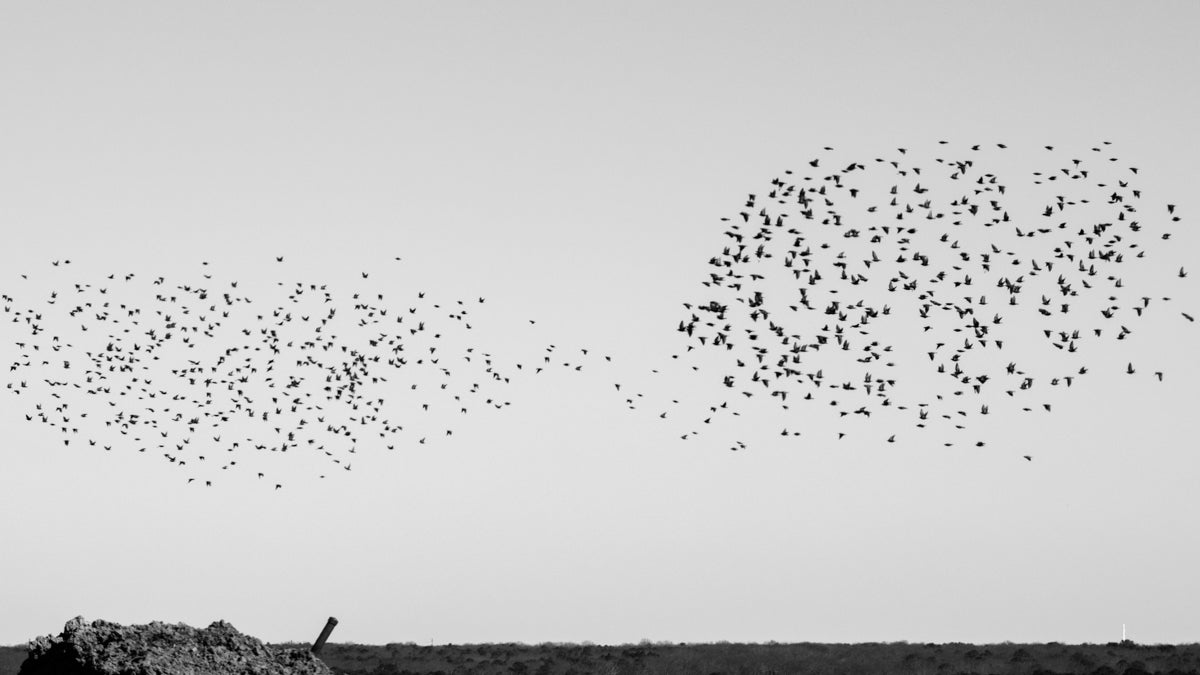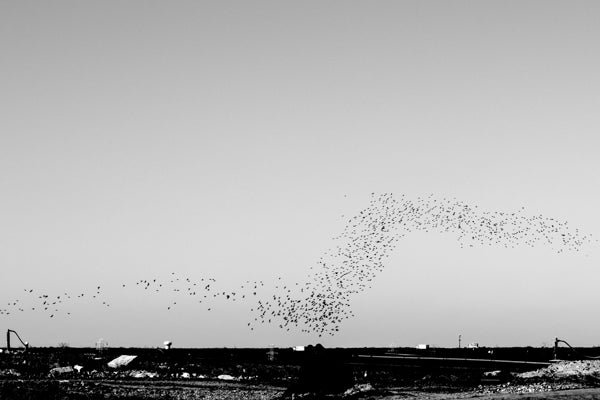Synchronized defense: How animals move as one to avoid predators
When watching these birds move, it looks like they're one giant organism with a centralized brain. But an ornithologist explains it's not one brain so much as one thought.
Listen 5:49
A starling murmuration over Atlantic County Utilities Authority in New Jersey. (Paige Pfleger/WHYY)
The view on top of Atlantic County’s landfill stretches off into the distance, over the tops of deep green pine trees. Wind turbines spin in front of Atlantic City’s skyline, and the ocean fades into the sky on the horizon.
On the ground, a bulldozer covers up a pile of garbage and, suddenly, a cloud of birds take to the sky — they assume a formation, perfectly spaced out, and begin an undulating dance. They soar upwards and swoop downwards, changing direction seamlessly.

These mesmerizing movements aren’t just for show. The birds are a murmuration of starlings, and they are grouping together to increase their chances at survival when a predator is around.
“So if there’s one predator coming in and there are a thousand of you starlings, and it’s a good predator, it is going to get one guaranteed. You have one chance in a thousand of being taken instead of being off on your own and the predator comes after you, and it’s just you,” explains Kevin McGowan, of Cornell’s lab of Ornithology.
When watching these birds move, it looks as though they’re one giant organism, with a centralized brain. But McGowan explains that it’s not one brain so much as one thought — avoid the predator by hiding behind your buddies.

Many different animals exhibit this kind of group behavior, from birds like starlings, red-billed quelea, or the dickcissel, to fish like anchovies, herring, or sardines. All of these animals have things in common that can help explain why they group together like this.
First, the animals have a uniform look to them.
“You don’t want to stand out in a crowd because standing out gets you noticed and getting noticed gets you eaten,” McGowan says.
And secondly, they’re all fairly easy prey.
“They’re tasty, tender and delicious I suppose! There are things that want to eat them and they’re usually smallish and vulnerable,” McGowan adds with a laugh.

One of the most striking things about these group behaviors is that there is no leader — no one bird or one fish is directing others to turn one way or another. They follow a series of rules that physicists like Andrea Cavagna have been trying to understand for decades.
Cavagna is a researcher at the University of Rome, and has authored some of the groundbreaking research about how murmurations of starlings move the way they do.
He explains that each individual bird doesn’t need to communicate with the whole flock — instead they just need to imitate their seven to 10 closest neighbors. When they do that, the flock looks like it’s moving as one, no matter how many birds are part of the system.
He says it’s kind of like a giant game of telephone, except the birds are passing a movement instead of a phrase.
“If there is a flock of 50 birds and they play the telephone game, then the message travels for 50 birds. If the flock is of 10,000 birds and they play the game and the message travels to 10,000 people. So the scale over which they are globally correlated is always as large as the entire system. This is why they give the striking appearance of behaving like one,” Cavagna says.

Cavagna’s research so far has focused on murmurations of starlings, but he’s trying to find a connection between all group behavior in the animal kingdom.
“For me, the next big step would be to try to find a characterization of collective behavior which transcends different systems – so instead of saying birds do this, swarms do that, herds do that – to try to find some general or universal features which are common to many instances of collective behavior within biology.”
He explains that these perfectly synchronized animal group behaviors could also be harnessed for new technological innovations. Right now, most groups of machines, like drones, move in a follow-the-leader-like fashion. If the leader gets destroyed, the group stops functioning.
“On the other hand, collective behavior in biology is most of the time decentralized, distributed behavior, so it’s a bottom up kind of control which is much more robust. So it would be very useful to be able to copy that at the technological level,” Cavagna says.
Think schools of unmanned submarines that search for underwater mines, or a flock of microscopic robots inside our bodies that administer medicine.
If we can teach those man-made machines to move like these synchronized birds, it could make them less vulnerable to predators, too.

WHYY is your source for fact-based, in-depth journalism and information. As a nonprofit organization, we rely on financial support from readers like you. Please give today.






